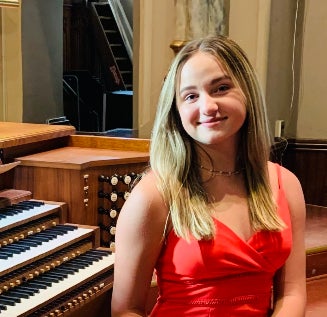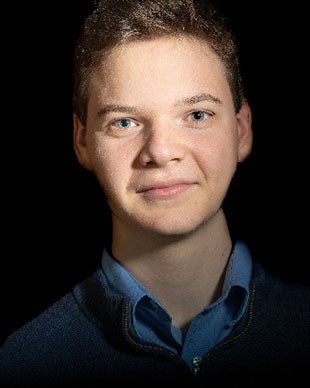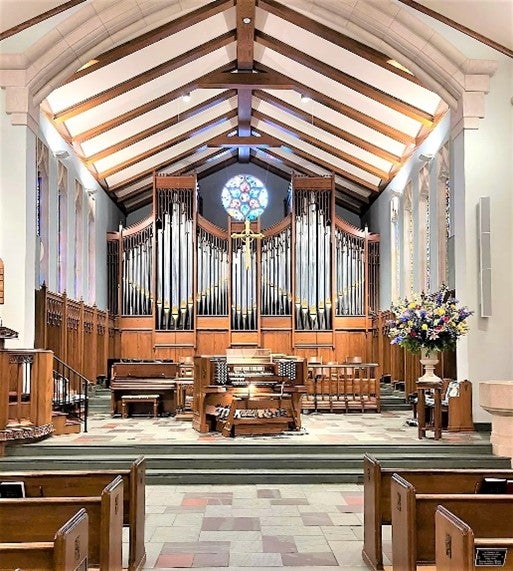The first contestant sits down at the organ bench, and for a moment the only sounds are of adjustments she makes to the grand instrument in front of her and the turning of songbook pages.
The small, intimate audience waits patiently as the young woman takes a deep breath, relaxes her shoulders and begins. The silence breaks suddenly into an explosion of rolling notes from the opening of Bach’s “Prelude and Fugue in C Minor, BWV 549,” and an air of reverence immediately swells throughout the room.
This was the scene Sunday June 18 at the Young Organist Competition that opened the Southeastern Regional Convention of the American Guild of Organists (AGO). The conference, which ran from June 18 to June 21, was attended by nearly 150 organists and was hosted by the Aiken/Augusta chapter of the organization.
The Young Organist Competition saw only two young competitors, Abigail Crafton of Savannah and Nathan Barcelona of Clemson, S.C., but though their numbers were few, the power and longevity of the organ still resonated through them and their performances.

For someone who is just a few years older than the competitors, there was a sort of cognitive dissonance between what I was seeing and hearing. Something was odd to me about seeing such young people take such powerful command over this storied, historically rich instrument. However, something it felt like an important moment.
I spoke with one of the competitors, Nathan Barcelona, who explained why he is passionate about the organ: “I believe creativity is a way of communicating basic thoughts to another. Through this bridge, we are able to relate through any language or cultural barriers.”
This phenomenon was most clear in the portion of each competitor’s program where the audience was invited to sing along. Both organists played well-known hymns – “Abide with Me” and “Christ is Made the Sure Foundation.” The audience was small, so the volume of their singing took me by pleasant surprise. It really was one of those moments of connection, feeling united with these people I’ve never spoken to by a common experience.

But more and more young people are missing out on this experience today. Young Organist Convener for the AGO Jillian Gardner confirmed that the rise in contemporary music in churches has seen a continuing decline in youth interest in the organ due to lowered exposure.
But hope for the instrument is not dashed. According to Gardner, who led a project that got more than 1,200 new young members into the AGO last year, “On the flip side, with the rise of social media, YouTube, and TikTok, etc., we are reaching more people than ever before.”
I have some firsthand experience with this. One of my all-time favorite songs, Jeff Buckley’s “Lover, You Should’ve Come Over,” begins on a nearly minute-long organ solo that evokes loss, longing and hope all at once. The song commands both solemnity and emotionality. This song’s recent resurgence in popularity due to its use on TikTok hopefully signifies the space that still remains for the organ today, despite its overall decline in popularity.
In fact, the organ is a bit of an under-recognized stalwart in the music industry. Most music studios have a Hammond B3 electric organ on deck. When you think of secular music, the organ is most likely not the first instrument to come to mind, but it is certainly there.
Gardner also said, “There is a rise in playing popular movie music on the organ for example. It gives your audience something familiar to associate with the organ, which is very cool for someone very new to the instrument.”
This called on a thought I had in viewing the Young Organist Competition: that it all sounded so cinematic. I’m not sure I’ve ever heard live music sound so transportive, like I’d stepped right into a movie score.
However, there’s work to be done on the ground level, as well.
Gardner says that, “As far as maintaining youth interest in the organ, I believe that is every person’s job in this field. We have to always be welcoming to young students of any child that may walk up to you at church. You have to let them sit on the bench and play around. That is how that initial interest sparks.”
Barcelona confirms this viewpoint, saying, “What originally brought me to the organ was the organ, not a high energy social media campaign. I believe the way we introduce the organ into people’s lives is by doing just that. Play the organ at church and expose people to the beauty of historical sacred liturgy. That is what will bring people back to the organ.”
It is clear that–though social media and internet resources can keep the organ from fading into obscurity–it is hands-on work with the youth that will keep practice, creation and reinvention in the world of organ music alive.
Whether viewed in its religious context or not, organ music is something powerful, and hopefully its place in the world continues to be sustained on a personal level by organizations like the AGO and on a worldwide level by our increased ability to share it with one another online.
Barcelona says, “I am not ready to give up on the history of the organ, and I do not feel like young people around the world are either.”
I would have to agree.
Mary Beth Bryant is an intern at the Augusta Press. She is presently a student at the University of Georgia.








